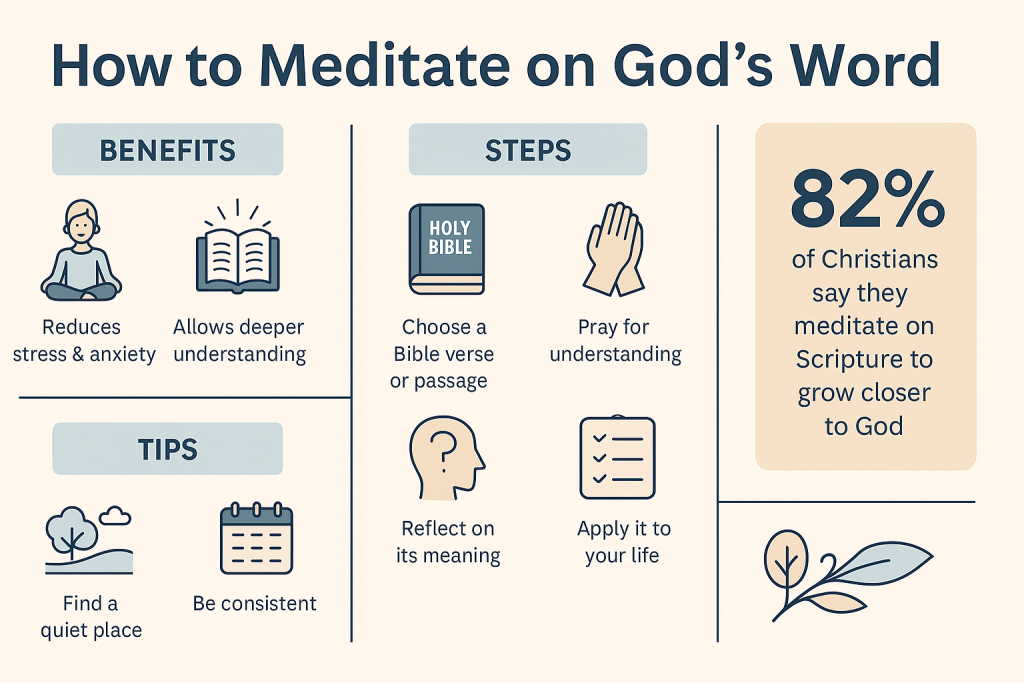How to Meditate on God’s Word (Calm, Real, Doable)
We may earn a commission for purchases made using our links. Please see our disclosure to learn more.
You want more than skimming verses—you want Scripture to settle into your bones and steady your days. If you’ve been wondering how to meditate on God’s Word, here’s a gentle, practical way to start (and keep going). You’ll get a simple daily rhythm, how to choose passages, ways to pray the text, and tools that make the habit stick—without feeling forced or “perfect.”
Affiliate Disclosure: I may earn a commission from qualifying Amazon purchases.
What Biblical Meditation Really Means
Biblical meditation isn’t emptying your mind—it’s filling it with the words God speaks, until they shape how you think, feel, and act. Picture tea leaves steeping in hot water: the longer Scripture sits in you, the richer your life tastes. The goal isn’t information overload; it’s slow attention that becomes obedience, comfort, and courage. You don’t need the “right vibe” to show up. Come as you are; let the Word do the work.
A Five-Step Framework You Can Keep
Here’s a five-step rhythm you can do in five to fifteen minutes:
- Arrive – two slow breaths; a simple “Here I am, Lord.”
- Read – a short passage (5–12 verses beats 50).
- Repeat – linger on one word or line that tugs at you.
- Respond – turn it into a short prayer; jot one honest sentence.
- Remember – carry a phrase with you through the day.
More time? Journal more. Less time? Keep steps 2–3–5. This scales with your season.
Set a Space That Helps You Settle
Pick a small corner: a comfy chair, a lamp, maybe a mug. Light instrumental music is fine if it helps you arrive. If grounding practices resonate (breath, posture, touch, light), this short read on cultivating steady presence via elemental energy can help your body settle while your mind meets the Word: how to create steady presence with elemental energy.
Tiny upgrades that help:
- A tray with Bible, pen, journal, highlighter
- A bookmark card with your five-step rhythm + memory verse slot
- A soft timer to keep it short and sweet

Begin With Breath and a Simple Prayer
Take a slow in-breath (count four), slow out-breath (count six). Then pray:
“Lord, open my mind to understand, my heart to receive, and my will to obey.”
You’ve just moved from hurry to holy attention. You’ll feel the difference in your pace.
Pick a Passage You Can Finish
Match your passage to your season:
- Psalms when emotions run high (joy, anxiety, grief).
- Gospels when you want to watch and walk with Jesus.
- Proverbs for one memorable line to carry.
- Epistles when you need crisp, practical guidance.
Shorter is better. Depth changes us more than breadth. If you’re tired, read half as much—linger twice as long.
Lectio Divina: Four Gentle Movements
This ancient practice fits modern life:
- Read (Lectio): What does the text say?
- Meditate (Meditatio): Which word/phrase calls your name?
- Pray (Oratio): Tell God what stirred; ask for help.
- Contemplate (Contemplatio): Rest in God’s presence—no performing.
Perfection isn’t the point. Honesty is. Over time, this rhythm rewires attention in a world that’s always tugging on it.
Ask Heart-Level Questions (Go From Page to Life)
A few good questions turn reading into transformation:
- What surprises me or challenges my assumptions?
- Where do I feel resistance to this truth?
- If I trusted this today, what would change?
- Who could be blessed if I live this out?
Write one sentence for one question. Tiny steps travel farther than grand intentions.
Pray Scripture Back to God
Turning verses into prayers helps truth travel from page to pattern.
Examples:
- “The Lord is my shepherd… Jesus, lead my choices in that 2 PM meeting.”
- “Cast all your anxiety on Him… I’m handing You this deadline and my pace.”
- “Your word is a lamp… Light the next step, not the whole highway.”
When words feel hard, pray the exact verse—slowly. Scripture carries you when you can’t carry yourself.
Practice Holy Imagination (See the Scene)
In Gospel passages, picture the moment: dust, light, voices. Where are you standing? What does Jesus’ face look like? What tone is in His question? This isn’t make-believe; it’s mindful attention that helps you notice details you’d miss at full speed. Prompt: “Where am I in this scene, and what do I say to Jesus?”
Journal One Insight, One Next Step
Keep it tiny:
- I notice: a word, a nudge, a comfort, a correction.
- I will: one concrete action (apology, text, generosity, patience in one moment).
Spiritual growth is mostly small steps done steadily. You’re building a path, not staging a performance.
Memorize One Line for the Day
Pocket a phrase; repeat it between emails and errands:
- “Be still, and know…”
- “The Lord is my shepherd.”
- “Your word is a lamp…”
That’s how renewing the mind becomes a daily practice, not a once-a-week wish. You’ll find the line rising on its own when you need it most.
Habits, Roadblocks, and Kind Solutions
Stack the habit. Tie it to a cue you already do (coffee, commute, lunch).
Use micro-moments. Morning 7 minutes, midday whisper, evening gratitude.
Expect distraction. Keep a scrap paper for pop-up to-dos; write them down and return to the text.
Feelings will vary. Faithfulness is the measure, not fireworks.
Don’t stall on “I don’t understand.” Camp on what you do see; that’s today’s assignment. Understanding grows with returning.
Bonus: create a “grace plan” for busy weeks—one psalm, one breath prayer, one line to carry.
Amazon Picks to Support Your Practice
ESV Study Bible (Hardcover, Crossway)
A deeply resourced Bible with maps, charts, and articles so you can see the context behind what you’re meditating on.
Features: 20,000+ notes; 200+ charts; 240+ maps; 50+ articles.
Pros: Rich scholarship; durable build.
Cons: Bulky; smaller print for some.
Best for: In-home study and deeper dives.
Review snapshot: Praise for depth; some wish it were lighter.
NIV Journal the Word Bible (Hardcover, Zondervan)
Wide margins and thicker paper invite prayer notes, prompts, and verse art.
Features: Extra-wide margins; red-letter text; cream paper; Comfort Print type.
Pros: Room to breathe; readable layout.
Cons: Not a full study apparatus.
Best for: Reflective note-takers, creative journaling.
Kindle (11th Gen, 2022 release)
A lightweight, budget-friendly way to keep Scripture with you—easy on the eyes and great for travel or bedtime reading.
Features: 6″ 300 ppi glare-free display; 16 GB storage; USB-C charging; adjustable front light; weeks of battery life.
Pros: Affordable; ultra-portable; crisp text; long battery.
Cons: Smaller screen than Paperwhite; no warm light setting.
Best for: Budget-minded daily readers, commuters, and travelers.
Mr. Pen Bible Gel Highlighters (No-Bleed)
Gentle gel formula highlights without bleeding through thin Bible pages.
Features: No-bleed gel; no-smear design; assorted colors; twist-up sticks.
Pros: Bible-safe; smooth glide; won’t dry out quickly.
Cons: Can feel waxy if pressed hard.
Best for: Color-coding themes and promises.
Moleskine Classic Notebook (Large, Ruled)
A durable journal for prayers, gratitude, and action steps.
Features: Hard cover; elastic band; ribbon bookmark; back pocket.
Pros: Professional look; toss-in-bag tough.
Cons: Not ideal for heavy markers.
Best for: Daily Scripture journaling and sermon notes.
Quick Comparison Table
| Model | Key Spec(s) | Warranty | Approx Price/Tier | Best For |
| ESV Study Bible | 20k+ notes; charts & maps | Publisher varies | $$ | Deep study at home |
| NIV Journal the Word | Wide margins; Comfort Print | Publisher varies | $$ | Note-taking & reflection |
| Kindle (11th Gen, 2022) | 6″ 300 ppi; 16 GB; USB-C; weeks of battery | 1-yr typical | $–$$ | Budget readers & travel |
| Mr. Pen Gel Highlighters | No-bleed gel; assorted colors | Manufacturer varies | $ | Color-coding verses |
| Moleskine Classic | Hard cover; ribbon; pocket | Manufacturer varies | $–$$ | Prayer & verse journaling |
Tip: If your budget is tight, start with a single notebook and your current Bible. Add tools later.

Research-Backed Benefits of Scripture Meditation
- Bible reading, stress, and hope: A peer-reviewed study found that people who read the Bible more often reported greater hope when facing stressful life events, partly because Scripture reading was linked to more benevolent religious reappraisal (seeing hardship through a hopeful, faith-based lens). See “Reading the Bible, Stressful Life Events, and Hope” (Krause & Pargament, 2018) for details (observational evidence, not proof of causation).
- Prayer style matters for anxiety: Using nationally representative U.S. data, researchers showed that the type of prayer (e.g., praise, asking forgiveness, prayers for support) and expectancies about whether God answers prayer relate differently to anxiety—some prayer forms correlate with lower anxiety, others with higher anxiety. For nuance on how spiritual practices relate to mental health, see “Unpacking the Relationship Between Prayer and Anxiety” (Upenieks, 2022/2023).
FAQs
How long should I meditate on God’s Word each day?
Aim for 10–15 minutes most days. Small and steady beats long and rare. Your future self will be grateful you kept showing up.
What translation is best for meditation?
The one you’ll actually read. Many love ESV for study, NIV/CSB for readability, and NLT for smooth devotional flow. Try a few for a week each.
Can I meditate on one verse for a whole week?
Absolutely. Let the same line shape different moments—work, family, rest. Depth grows when you linger, not when you rush.
How do I stay focused when my mind wanders?
Keep a “catch list” nearby. Jot the stray thought, then return to your verse. Breathe, read the line again—slower. Distraction doesn’t disqualify you.
Is music or an app okay during meditation?
Yes. Gentle instrumentals help some people. Apps or e-readers are fine if they reduce friction and keep you returning.
Final Encouragement
You don’t need perfect mornings or perfect focus. You need a place to sit, a short passage, and a willing heart. When you meditate on God’s Word, you’re not earning spiritual gold stars; you’re letting God’s voice set the tone for your day. Start with one line, one honest prayer, and one faithful step. I’m rooting for you.




